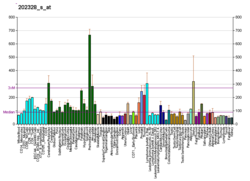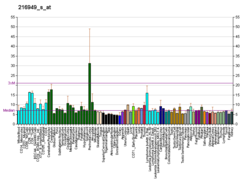Family of transport proteins
Polycystin 1 (PC1 ) is a protein that in humans is encoded by the PKD1 gene .[ 5] [ 6] PKD1 are associated with most cases of autosomal dominant polycystic kidney disease , a severe hereditary disorder of the kidneys characterised by the development of renal cysts and severe kidney dysfunction.[ 7]
Protein structure and function
PC1 interacts with polycystin 2 by a cytoplasmic coiled-coil domain. PC1 is a membrane-bound protein 4303 amino acids in length expressed largely upon the primary cilium , as well as apical membranes , adherens junctions , and desmosomes .[ 8] transmembrane domains , a large extracellular N-terminal domain, and a short (about 200 amino acid) cytoplasmic C-terminal domain.[ 8] [ 9] coiled-coil domain through which PC1 interacts with polycystin 2 (PC2), a membrane-bound Ca2+ -permeable ion channel .
PC1 has been proposed to act as a G protein–coupled receptor .[ 8] [ 10] cell nucleus in response to decreased fluid flow in the mouse kidney.[ 11] STAT6 and p100 , or components of the canonical Wnt signaling pathway in an inhibitory manner.[ 12] [ 13]
The structure of the human PKD1-PKD2 complex has been solved by cryo-electron microscopy , which showed a 1:3 ratio of PKD1 and PKD2 in the structure. PKD1 consists of a voltage-gated ion channel fold that interacts with PKD2.[ 14]
PC1 mediates mechanosensation of fluid flow by the primary cilium in the renal epithelium and of mechanical deformation of articular cartilage .[ 15]
Gene
Splice variants encoding different isoforms have been noted for PKD1 . The gene is closely linked to six pseudogenes in a known duplicated region on chromosome 16p.[ 16]
References
^ a b c GRCh38: Ensembl release 89: ENSG00000008710 – Ensembl , May 2017^ a b c GRCm38: Ensembl release 89: ENSMUSG00000032855 – Ensembl , May 2017^ "Human PubMed Reference:" . National Center for Biotechnology Information, U.S. National Library of Medicine .^ "Mouse PubMed Reference:" . National Center for Biotechnology Information, U.S. National Library of Medicine .^ Hughes J, Ward CJ, Peral B, Aspinwall R, Clark K, San Millán JL, Gamble V, Harris PC (June 1995). "The polycystic kidney disease 1 (PKD1) gene encodes a novel protein with multiple cell recognition domains". Nature Genetics . 10 (2): 151– 60. doi :10.1038/ng0695-151 . PMID 7663510 . S2CID 20636101 . ^ "Polycystic kidney disease: the complete structure of the PKD1 gene and its protein. The International Polycystic Kidney Disease Consortium" . Cell . 81 (2): 289– 98. April 1995. doi :10.1016/0092-8674(95)90339-9 PMID 7736581 . S2CID 11114706 .^ Torres VE, Harris PC, Pirson Y (April 2007). "Autosomal dominant polycystic kidney disease". Lancet . 369 (9569): 1287– 301. doi :10.1016/S0140-6736(07)60601-1 . PMID 17434405 . S2CID 1700992 . ^ a b c Zhou J (2009). "Polycystins and primary cilia: primers for cell cycle progression". Annual Review of Physiology . 71 : 83– 113. doi :10.1146/annurev.physiol.70.113006.100621 . PMID 19572811 . ^ Dalagiorgou G, Basdra EK, Papavassiliou AG (October 2010). "Polycystin-1: function as a mechanosensor". The International Journal of Biochemistry & Cell Biology . 42 (10): 1610– 3. doi :10.1016/j.biocel.2010.06.017 . PMID 20601082 . ^ Trudel M, Yao Q, Qian F (January 2016). "The Role of G-Protein-Coupled Receptor Proteolysis Site Cleavage of Polycystin-1 in Renal Physiology and Polycystic Kidney Disease" . Cells . 5 (1): 3. doi :10.3390/cells5010003 PMC 4810088 PMID 26805887 . ^ Chauvet V, Tian X, Husson H, Grimm DH, Wang T, Hiesberger T, Hieseberger T, Igarashi P, Bennett AM, Ibraghimov-Beskrovnaya O, Somlo S, Caplan MJ (November 2004). "Mechanical stimuli induce cleavage and nuclear translocation of the polycystin-1 C terminus" . The Journal of Clinical Investigation . 114 (10): 1433– 43. doi :10.1172/JCI21753 . PMC 1052027 PMID 15545994 . ^ Low SH, Vasanth S, Larson CH, Mukherjee S, Sharma N, Kinter MT, Kane ME, Obara T, Weimbs T (January 2006). "Polycystin-1, STAT6, and P100 function in a pathway that transduces ciliary mechanosensation and is activated in polycystic kidney disease" . Developmental Cell . 10 (1): 57– 69. doi :10.1016/j.devcel.2005.12.005 PMID 16399078 . ^ Lal M, Song X, Pluznick JL, Di Giovanni V, Merrick DM, Rosenblum ND, Chauvet V, Gottardi CJ, Pei Y, Caplan MJ (October 2008). "Polycystin-1 C-terminal tail associates with beta-catenin and inhibits canonical Wnt signaling" . Human Molecular Genetics . 17 (20): 3105– 17. doi :10.1093/hmg/ddn208 . PMC 2722884 PMID 18632682 . ^ Shi Y, Mei C, Zhou Q, Wang T, Yu S, Lei J, Ge X, Hu F, Su Q (2018-09-07). "Structure of the human PKD1-PKD2 complex" . Science . 361 (6406): eaat9819. doi :10.1126/science.aat9819 ISSN 0036-8075 . PMID 30093605 . ^ Nauli SM, Alenghat FJ, Luo Y, Williams E, Vassilev P, Li X, Elia AE, Lu W, Brown EM, Quinn SJ, Ingber DE, Zhou J (February 2003). "Polycystins 1 and 2 mediate mechanosensation in the primary cilium of kidney cells". Nature Genetics . 33 (2): 129– 37. doi :10.1038/ng1076 . PMID 12514735 . S2CID 23149223 . ^ "Entrez Gene: PKD1 polycystic kidney disease 1 (autosomal dominant)" .
External links
TRPA
Activators
4-Hydroxynonenal 4-Oxo-2-nonenal 5,6-EET 12S-HpETE 15-Deoxy-Δ12,14 -prostaglandin J2 α-Sanshool (ginger , Sichuan and melegueta peppers )Acrolein Allicin (garlic )Allyl isothiocyanate (mustard , radish , horseradish , wasabi )AM404 ASP-7663 Bradykinin Cannabichromene (cannabis )Cannabidiol (cannabis )Cannabigerol (cannabis )Cinnamaldehyde (cinnamon )CR gas (dibenzoxazepine; DBO) CS gas (2-chlorobenzal malononitrile) Cuminaldehyde (cumin )Curcumin (turmeric )Dehydroligustilide (celery )Diallyl disulfide Dicentrine (Lindera Farnesyl thiosalicylic acid Formalin Gingerols (ginger )Hepoxilin A3 Hepoxilin B3 Hydrogen peroxide Icilin Isothiocyanate JT-010 Ligustilide (celery , Angelica acutiloba Linalool (Sichuan pepper , thyme )Methylglyoxal Methyl salicylate (wintergreen )N-Methylmaleimide Nicotine (tobacco )Oleocanthal (olive oil )Paclitaxel (Pacific yew )Paracetamol (acetaminophen) PF-4840154 Phenacyl chloride Polygodial (Dorrigo pepper )Shogaols (ginger , Sichuan and melegueta peppers )Tear gases Tetrahydrocannabinol (cannabis )Tetrahydrocannabiorcol Thiopropanal S-oxide (onion )Umbellulone (Umbellularia californica )WIN 55,212-2 Blockers
TRPC
TRPM
TRPML
TRPP
TRPV
Activators
2-APB 5,6-EET 9-HODE 9-oxoODE 12S-HETE 12S-HpETE 13-HODE 13-oxoODE 20-HETE α-Sanshool (ginger , Sichuan and melegueta peppers )Allicin (garlic )AM404 Anandamide Bisandrographolide (Andrographis paniculata Camphor (camphor laurel , rosemary , camphorweed , African blue basil , camphor basil )Cannabidiol (cannabis )Cannabidivarin (cannabis )Capsaicin (chili pepper )Carvacrol (oregano , thyme , pepperwort , wild bergamot , others)DHEA Diacyl glycerol Dihydrocapsaicin (chili pepper )Estradiol Eugenol (basil , clove )Evodiamine (Euodia ruticarpa Gingerols (ginger )GSK1016790A Heat Hepoxilin A3 Hepoxilin B3 Homocapsaicin (chili pepper )Homodihydrocapsaicin (chili pepper )Incensole (incense )Lysophosphatidic acid Low pH (acidic conditions)
Menthol (mint )N-Arachidonoyl dopamine N-Oleoyldopamine N-Oleoylethanolamide Nonivamide (PAVA) (PAVA spray )Nordihydrocapsaicin (chili pepper )Paclitaxel (Pacific yew )Paracetamol (acetaminophen) Phenylacetylrinvanil Phorbol esters (e.g., 4α-PDD )Piperine (black pepper , long pepper )Polygodial (Dorrigo pepper )Probenecid Protons RhTx Rutamarin (Ruta graveolens Resiniferatoxin (RTX) (Euphorbia resinifera /pooissonii Shogaols (ginger , Sichuan and melegueta peppers )Tetrahydrocannabivarin (cannabis )Thymol (thyme , oregano )Tinyatoxin (Euphorbia resinifera /pooissonii Tramadol Vanillin (vanilla )Zucapsaicin Blockers









